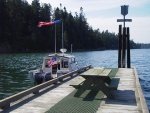ggray
New member
- Joined
- Jun 3, 2020
- Messages
- 63
- Reaction score
- 0
- C Dory Year
- 2007
- C Dory Model
- 22 Cruiser
- Vessel Name
- Red Top
We don't fish, so I removed the Lowrance HDS on the 22 Cruiser we bought last summer to make room for a small kicker.
I plan to mount a digital depth sounder, and it looks like the easiest to fit in the dash area are the HawkEye, which I have had experience with, and a Faria, of which I know nothing.
Are there any others I should consider? Opinions on the HawkEye or Faria? The Raymarine unit on our sailboat is larger that I had hoped to use.
The HawkEye we have on a small power boat works OK most of the time, and I think the times it doesn't are related to the transom mount of the transducer.
So the second question is whether anyone has installed a deck plate under the portapotty, removed the foam, and glued a transducer inside the hull there. (I "think" there is enough room.)
If so, how well does it work?
I plan to mount a digital depth sounder, and it looks like the easiest to fit in the dash area are the HawkEye, which I have had experience with, and a Faria, of which I know nothing.
Are there any others I should consider? Opinions on the HawkEye or Faria? The Raymarine unit on our sailboat is larger that I had hoped to use.
The HawkEye we have on a small power boat works OK most of the time, and I think the times it doesn't are related to the transom mount of the transducer.
So the second question is whether anyone has installed a deck plate under the portapotty, removed the foam, and glued a transducer inside the hull there. (I "think" there is enough room.)
If so, how well does it work?

